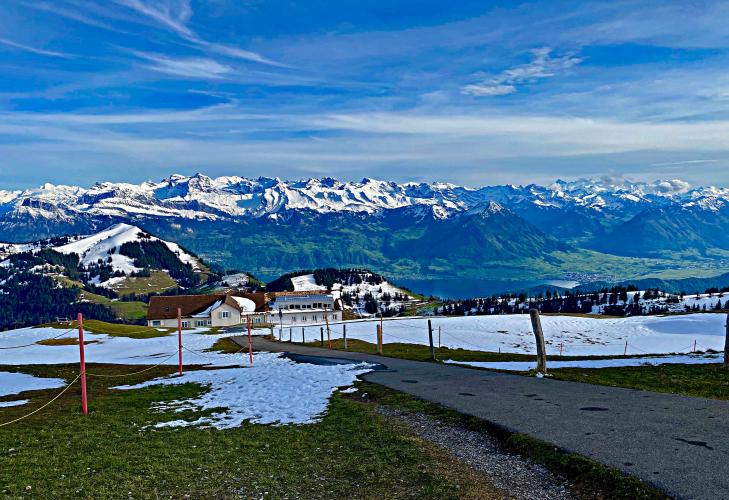![Cycling Mt Rigi, Switzerland Panoramic views of snow capped mountaintops, bike leaning against fence on mountain side, lake in the distance]()
Cycling Mount Rigi, Switzerland: A World Top 100 bike climb.
Ride 12.2 kilometers gaining 1,241 meters at 10.2% average grade.
A more scenic, but longer ride is to begin at Lake Zugersee which adds about four kilometers to the climb (Map).
Summary of the Mt. Rigi climb by Ard Oostra of Montreux, Switzerland. Note that Ard began his climb at Lake Zugersee.
There are some very steep sections, especially in the last kilometers before the summit. The hairpins between the kulm train stations (second railway crossing; 1600m altitude), and the summit (at 1800m altitude) are steep, and the surface is composed of concrete slabs in bad condition, including loose gravel on the concrete that may make your bike’s rear wheel slip.
![Cycling Mount Rigi, Switzerland Cycling Mount Rigi, Switzerland - sailboats on crystal clear lake, clouds and Mt. Rigi in distance (also reflected in the water), Mt. Rigi from the roadside, green hillsides with Mt. Rigi in the background, PJAMM Cycling logo in corner]()
Our destination: Mount Rigi.
The middle section of the ascent has some gravel sections (each consisting of a couple hundred meters), which in the steeper parts demand some climbing skills. Fortunately there is a brand new paved section on a steep part (about 500m in length, at about 1300m altitude), which was previously gravel road.
![Cycling Mount Rigi, Switzerland Cycling Mount Rigi, Switzerland - views looking down the mountainside show snow in mid-May]()
The ascent between Goldau (600m) and the first railway crossing (1150m) is a narrow, winding, fairly steep, paved road in good condition with little traffic, since from 800m altitude only cars with permits can drive on the road. The first part of the climb (between lake shore at Arth and the village of Goldau) is a wide main road, with low grade. The scenery in this area is grassland with grazing cows, and forest (creating shadowy roadways and cooler temperatures on the northeast side of the mountain).
![Cycling Mount Rigi, Switzerland Cycling Mount Rigi, Switzerland - bike stopped along roadside, narrow, one-lane, gravel roadway]()
The Rigi mountain is in the “Zentral Schweiz,” the central part of Switzerland: the cantons of Luzern, Schwytz, Uri, and Nidwald. Also called the “primitive Switzerland,” the place of the founding fathers of Switzerland. This core of Switzerland was founded in the 12th century, and the region still has many traditions, with the people being proud and patriotic. The farmers have a high esteem. When climbing on “their” mountain roads, don’t expect them to give way to a cyclist (with their car, tractor, or cattle) even when the road is steep and narrow. It’s their land! This said, if you show yourself to be polite and friendly (it helps if you speak German 😉) they usually open up somewhat. For example, if you ask for directions, because -- surprise! Nowhere on the road are there signs for the Rigi summit (tourists are supposed to take the train up or take the hiking trails).
![Cycling Mount Rigi, Switzerland Cycling Mount Rigi, Switzerland - snowy mountainside with lake in distance]()
The top of Mt. Rigi is normally very tourist-oriented, with national and international visitors. Most people take the train up, and some take the hiking trails. Few visitors bike up. According to a local cyclist that I met on his “haus berg” he does sometimes see MTB riders cycling up (of which more and more are e-bikes), but cyclists on a road bike are extremely rare. I have to admit that it was a tough climb on my race bike, due to the changing steepnesses and different road surfaces. At least a 23mm tire in front and 25mm in the back are highly recommended.
![Cycling Mount Rigi, Switzerland Cycling Mount Rigi, Switzerland - climb finish shows snow on summit during May, road signs, views looking down at lake]()
Climb finish.
On the day we did this climb (20th May, 2021), there was some fresh snow on the higher levels (above 1500m altitude) which is quite unusual for this time of the year. I was very lucky because it was a weekday and due to the Coronavirus restrictions all shops and restaurants at the summit are closed, and there are almost no international tourists. Under “normal” circumstances one should carefully pick the day and time to cycle the upper part of the road because there will be many hikers. Originally the road was only meant for the tourists walking from the last train station to the summit.
![Cycling Mount Rigi, Switzerland Cycling Mount Rigi, Switzerland - snowy mountain top]()
Warning: Be very careful in the first part of the downhill below the summit. It is steep, curvy, and has some loose gravel.
It is always possible to take the train down (even with your bike). The upper train station is very close to the summit.
The summit offers magnificent 360 degree views!
![Cycling Mount Rigi, Switzerland Cycling Mount Rigi, Switzerland - PJAMM Cyclist Aard Oostra stands with bike on top of Mt. Rigi, snow in background, lake below]()
Thank you Ard!!

 We've partnered with Sherpa-Map.com to bring you the best route planning tool. With a PRO Membership you can use this climb as a reference when creating your route.
We've partnered with Sherpa-Map.com to bring you the best route planning tool. With a PRO Membership you can use this climb as a reference when creating your route. 


